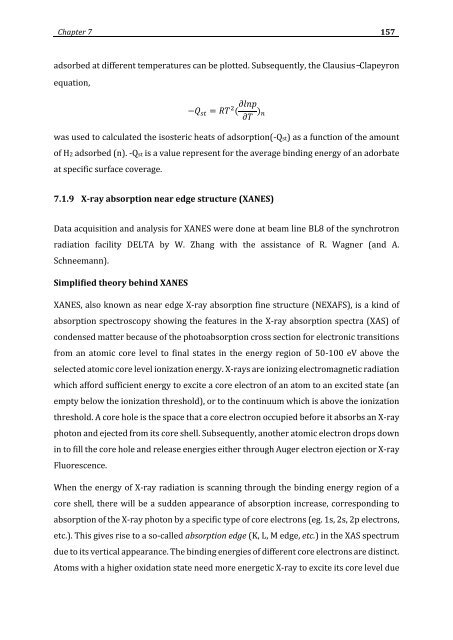Create successful ePaper yourself
Turn your PDF publications into a flip-book with our unique Google optimized e-Paper software.
Chapter 7 157<br />
adsorbed at different temperatures can be plotted. Subsequently, the Clausius−Clapeyron<br />
equation,<br />
−Q st = RT 2 ( ∂lnp<br />
∂T ) n<br />
was used to calculated the isosteric heats of adsorption(-Qst) as a function of the amount<br />
of H2 adsorbed (n). -Qst is a value represent for the average binding energy of an adorbate<br />
at specific surface coverage.<br />
7.1.9 X-ray absorption near edge structure (XANES)<br />
Data acquisition and analysis for XANES were done at beam line BL8 of the synchrotron<br />
radiation facility DELTA by W. Zhang with the assistance of R. Wagner (and A.<br />
Schneemann).<br />
Simplified theory behind XANES<br />
XANES, also known as near edge X-ray absorption fine structure (NEXAFS), is a kind of<br />
absorption spectroscopy showing the features in the X-ray absorption spectra (XAS) of<br />
condensed matter because of the photoabsorption cross section for electronic transitions<br />
from an atomic core level to final states in the energy region of 50-100 eV above the<br />
selected atomic core level ionization energy. X-rays are ionizing electromagnetic radiation<br />
which afford sufficient energy to excite a core electron of an atom to an excited state (an<br />
empty below the ionization threshold), or to the continuum which is above the ionization<br />
threshold. A core hole is the space that a core electron occupied before it absorbs an X-ray<br />
photon and ejected from its core shell. Subsequently, another atomic electron drops down<br />
in to fill the core hole and release energies either through Auger electron ejection or X-ray<br />
Fluorescence.<br />
When the energy of X-ray radiation is scanning through the binding energy region of a<br />
core shell, there will be a sudden appearance of absorption increase, corresponding to<br />
absorption of the X-ray photon by a specific type of core electrons (eg. 1s, 2s, 2p electrons,<br />
etc.). This gives rise to a so-called absorption edge (K, L, M edge, etc.) in the XAS spectrum<br />
due to its vertical appearance. The binding energies of different core electrons are distinct.<br />
Atoms with a higher oxidation state need more energetic X-ray to excite its core level due
















